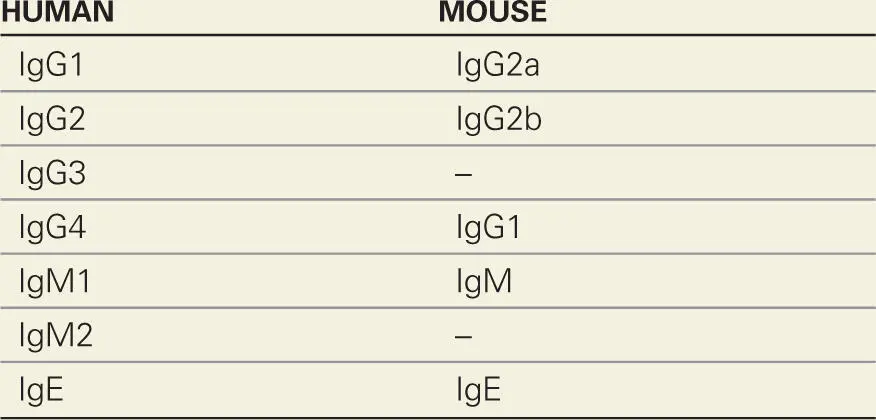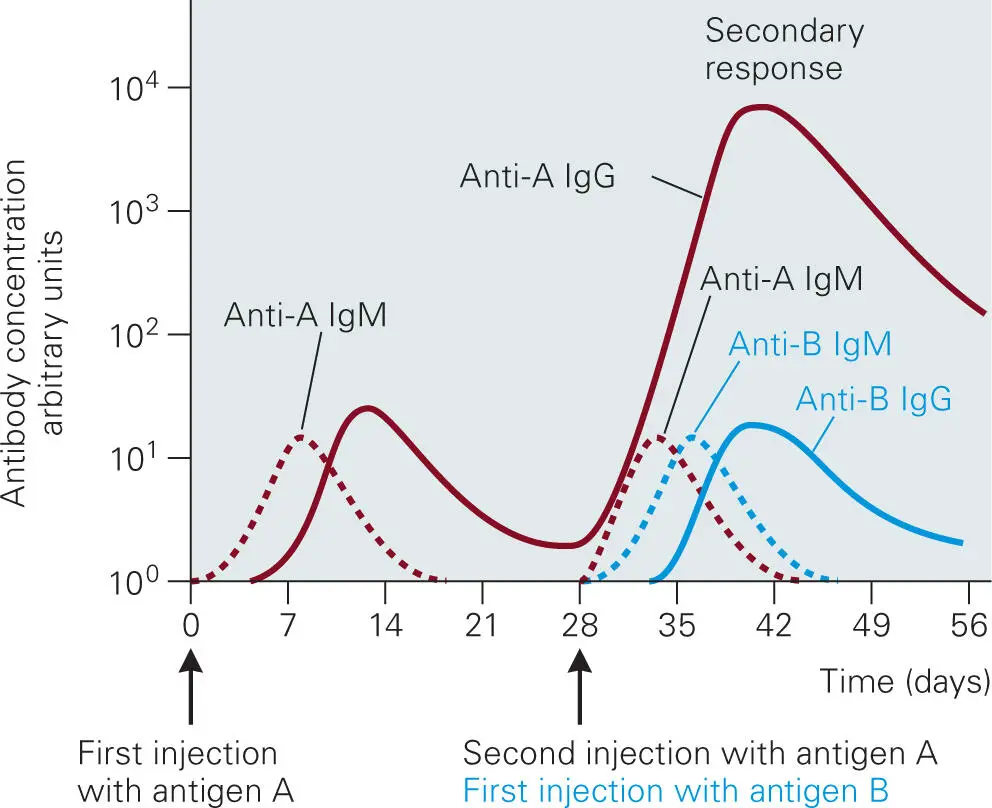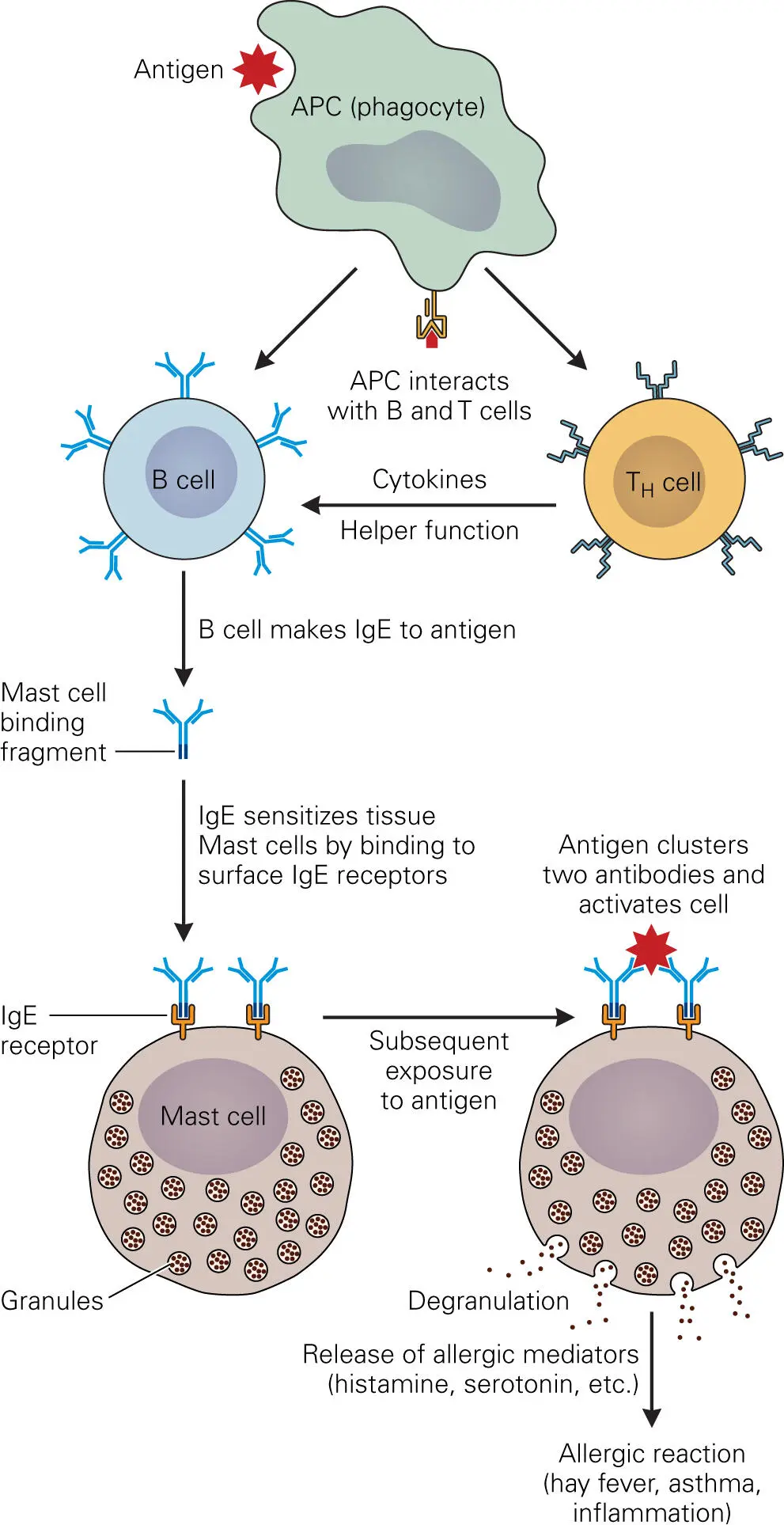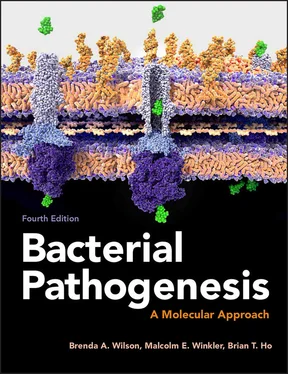Table 4-1. Protective roles of serum antibodies IgG and IgM

Box 4-1.
Are You a Human or a Mouse?
This archaic challenge, issued to someone showing classic symptoms of soft spine syndrome, in the hopes of getting that person to act decisively and courageously, actually applies to antibodies as well. Although humans and mice are much more closely related than many of us would like to admit, there are subtle but real differences between some antibody classes shared by humans and mice. Accordingly, there is also a somewhat different nomenclature used to designate these antibody classes. These different designations can be confusing, especially in the case of the IgG subtypes. A guide to the different antibody designations in humans and mice is provided below:

Why such differences occur between closely related species remains a fascinating but unanswered question.
IgG1 and IgG3, but not IgG2 and IgG4, strongly activate the classical pathway of the complement cascade. The six head domains of the C1q complex bind to the Fc region of IgG monomers bound to the surface of the antigen (see Figure 3-14). This cross-linking activates the C1 complex and initiates the complement cascade. IgG1 and IgG3 are also called opsonizing antibodies because these two subtypes are the most effective in opsonizing microbes due to the fact that they have the highest affinity to Fc receptors on phagocytes (see Figure 3-12). IgG2 and IgG4 opsonize poorly, if at all. IgG2 appears to be best at recognizing carbohydrate or polysaccharide-containing antigens. IgG4 appears to play a regulatory role by dampening Fc receptor-mediated inflammatory responses and is produced when persistent exposure to a particular antigen occurs.
Normally, antibody binding to an antigen on the surface of an extracellular pathogen facilitates ingestion of the opsonized antigen by phagocytic cells or triggers complement-dependent killing at the cell surface (see chapter 3). However, in the case of intracellular infections of tissues, IgG (mostly IgG1 and IgG3, but to some extent also IgG2, as well as IgA and IgE) can also mediate a different response, called antibody-dependent cell-mediated cytotoxicity (ADCC). In ADCC, antigens presented on the surfaces of infected cells bind to the Fab regions of specific IgG molecules. The exposed Fc portions of the IgG molecules are then free to bind to effector cells (PMNs, macrophages, or NK cells) that contain Fc receptors on their surfaces. In the case of NK cells, this linkage triggers a cytotoxic bombardment of the infected cell, as described in chapter 3. In the case of macrophages and PMNs a similar killing response can also be elicited, instead of phagocytosis. Thus, by linking together players of the innate (NK cells, PMNs, and macrophages) and adaptive (antibodies) immune responses, ADCC serves as an important defense against intracellular pathogens (more on this later).
IgM. IgM consists of a complex of five or more monomers that are connected via disulfide bonds to each other and to a peptide called the J-chain ( Figure 4-1). IgM is found mostly in serum, where it accounts for 5 to 10% of the total serum Ig, but it is also secreted at mucosal surfaces and in breast milk. IgM is the most effective activator of complement. Because of its polymeric form, a single molecule of IgM has five Fc regions that can be complexed, which is sufficient to bind C1q and strongly activate complement via the classical pathway or to bind and cluster multiple Fc receptors and mediate enhanced opsonization.
IgM is the first antibody type expressed in the fetus (at 20 weeks’ gestation). During B cell differentiation, IgM is the only antibody expressed by naïve B cells. Once B cells mature and proliferate, they start to produce IgG (or IgA) and IgM antibody expression wanes. IgM predominates in the initial (primary) antibody response against a pathogenic microbe, whereas IgG (or IgA at mucosal sites) predominates in response to sustained or subsequent infections (secondary antibody response) by the same microbe ( Figure 4-3). Because IgG can circulate in serum for long durations, detectable IgG levels may indicate the presence of a current infection that is well underway or may simply be the residue of a previous infection, whereas IgM levels are detectable during an initial infection but vanish once production of IgG antibodies begins. This aspect of the immune response is actually exploited by diagnostic labs to determine whether a patient is experiencing a first exposure (acute infection) to a particular microbe.

Figure 4-3. The time course of elicitation of antibodies upon initial exposure and subsequent exposure. After exposure to an antigen such as antigen A, IgM is usually the first antibody detected during an acute infection, but levels decrease again after about two weeks. It takes five to seven days for selection and proliferation of B cells producing IgG against antigen A to appear in the blood. After a period of time, the levels of IgG also decrease. Subsequent exposure to antigen A again results in production of IgM at about the same levels as after the first exposure, but the levels of antigen A-specific IgG are now much higher. In contrast, exposure to antigen B along with the second exposure to antigen A does not enhance the antigen B-specific IgG levels.
IgD. IgD monomer is initially coexpressed with IgM on the surface of mature B cells as they exit the bone marrow and migrate to peripheral lymphoid tissues. IgD appears to function primarily to signal B cell activation.
IgE. A serum antibody with a function different from that of IgG and IgM is IgE. IgE is a monomer that is normally found in extremely low concentrations in serum (only 0.05% of total Ig concentration), usually as an Fc receptor-bound complex on the surface of mast cells and basophils. If two IgE molecules bound to mast cells are complexed by a polyvalent antigen (i.e., an antigen with multiple antibody-binding sites), it causes clustering of the Fc receptors, which stimulates the mast cell to release granules containing potent proinflammatory chemokines, in particular the vasoactive amines histamine and serotonin, as well as leukotrienes and cytokines such as IL-4 and IL-13 ( Figure 4-4). These IgE-induced responses also initiate the strong inflammatory reactions associated with allergies and asthma ( Box 4-2).

Figure 4-4. Antibody-mediated mast cell degranulation. Antigen-mediated clustering of IgE bound to Fc receptors on mast cells triggers degranulation and release of allergic mediators, such as histamines, serotonin, vasoactive amines, and other inflammatory cytokines.
Box 4-2.
The Dark Side of Adaptive Immunity: Allergy and Autoimmunity
Hypersensitivity is a set of undesirable, uncomfortable, and sometimes fatal reactions resulting from an overstimulation of inflammatory responses that cause host damage. Allergens that cause hypersensitivity include plant pollens, fungal spores, insect venom, animal dander, house dust mites, some foods, and certain chemicals (e.g., poison ivy, latex, jewelry, detergents, cosmetics). There are five types of hypersensitivity with differing times of onset and immune mediators:
Читать дальше
















